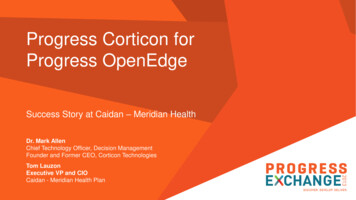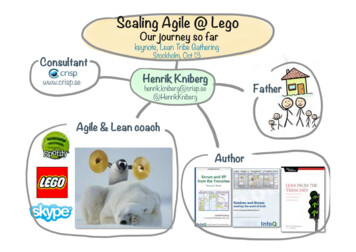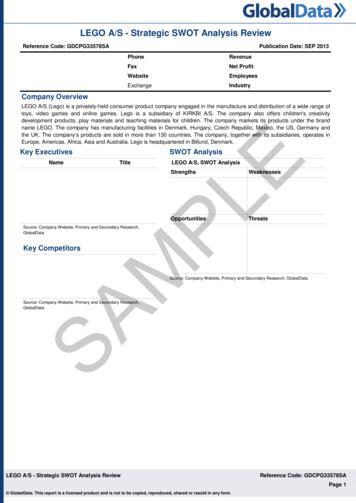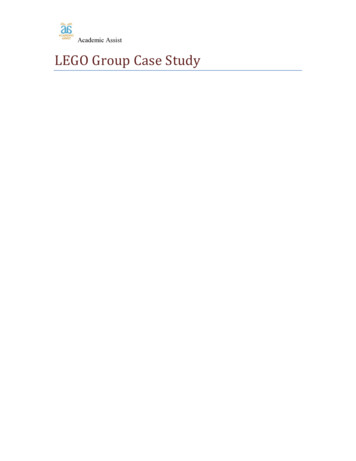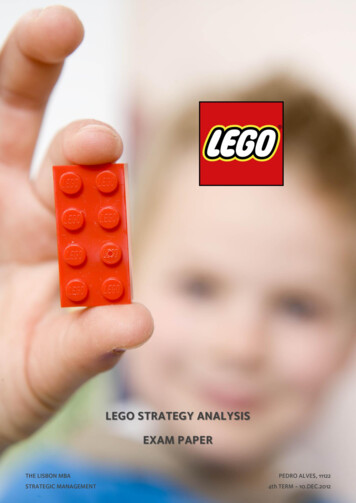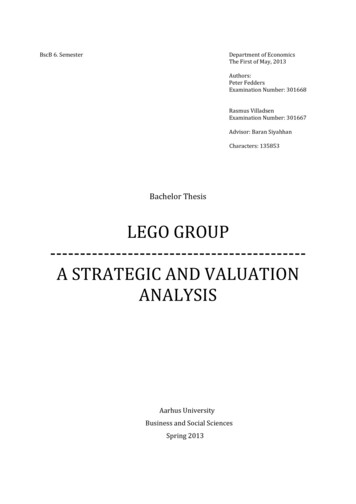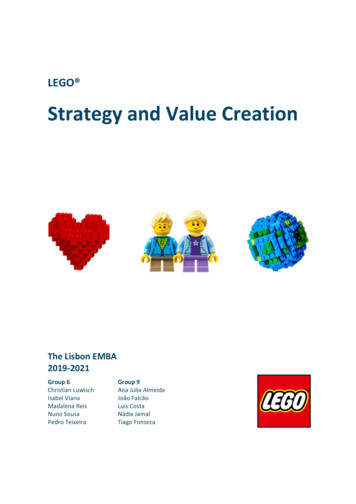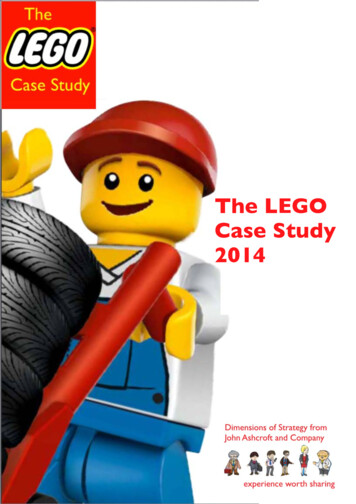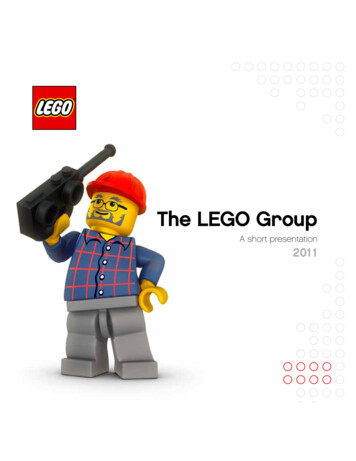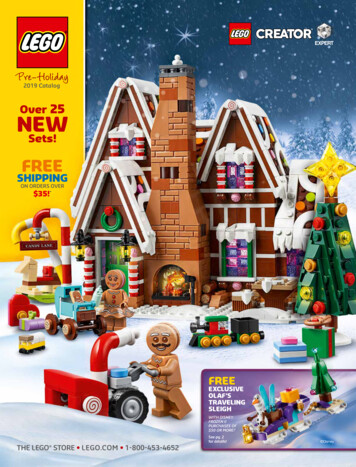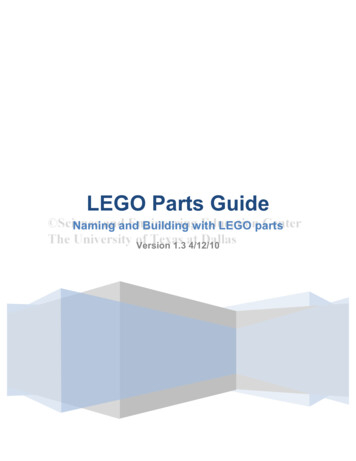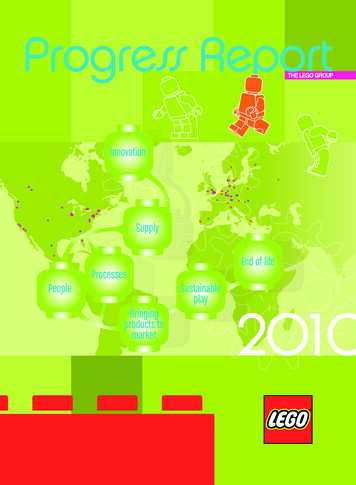
Transcription
Progress ReportThe LEGO GroupInnovationSupplyEnd of lifeProcessesSustainableplayPeopleBringingproducts tomarket2010
About this reportThis Progress Report 2010, together with the Annual Report 2010, constitutes the LEGOGroup’s reporting commitment for the year.Principles for reportingThe purpose of the Progress Report is to provide stakeholders with an overall fair andbalanced picture of relevant Environmental, Social, and Governance (ESG) aspects,engagements, practices, and results for 2010 at corporate level. We believe that theReport satisfies this purpose.This Report also serves as the annual communication on progress (Progress Report)required by United Nations Global Compact and is the statutory statement on CorporateSocial Responsibility according to section 99a of the Danish Financial Statements Act.The Report is developed in accordance with the main reporting principles of the Sustainability Reporting Guidelines from the Global Reporting Initiative (GRI). The selectionof ESG aspects reported is based on a dialogue with stakeholders and suggestionsfrom them. In addition, a materiality assessment is made based on among other theISO 26000 framework. Furthermore, the Report builds on processes that are part of theLEGO Group’s daily operations. Important stakeholders include consumers, customersand partners, employees and their representatives, potential employees, non-governmental organizations, and local communities affected by our operations.We believe that this approach is consistent with the principles of inclusiveness, materiality and responsiveness required of reporting organizations by the voluntary standardAA1000 Accountability Principles drawn up by the Institute of Social and Ethical Accountability (AccountAbility).Report structureThe Report is designed following our value chain to focus on how we strive to reachESG objectives and deliver on our ESG strategy, embed ESG the LEGO way, and accountfor the quality of our relationship with our stakeholders.Basis for the reportThe basis for the Report, scope, materiality determination, definitions, and calculationmethods are described in “The basis of the report” section. The Report has been subject to external verification and the auditors’ statement can be seen in the “Assurancestatement” section.Progress Report 2010is published for the LEGO Groupby Corporate Governance & Sustainabilityand Corporate Communications.Design and print: GRC Graphic HouseLEGO, the LEGO logo, the Brick configuration and the Minifigure are trademarks of the LEGO Group. 2011 The LEGO Group.Net Promoter, NPS and Net Promoter Score are trademarks of SatmetrixSystems Inc, Bain & Company and Fred Reichheld.Cradle to Cradle is a trademark of McDonough Braungart Design Chemistry(MBDC).We appreciate comments and feedback from all ourstakeholders. Please contact:Media: Charlotte SimonsenHead of Corporate Communicationsmedia@LEGO.comOther: Helle Sofie KaspersenVice President, Corporate Governance & Sustainabilitysustainability@LEGO.comPrinted matterLEGO A/SAastvej 1DK-7190 Billund, DenmarkTel:CVR-no:Residence:Reporting Year:Internet: 45 79 50 60 7054 56 25 19Billund1 January –31 Decemberwww.LEGO.com
contentsContentsPAGE Settingthe scene2About this report3Contents5Snapshot performance overview6Message from the CEO7Performance and target summary8The LEGO wayESG performance in the Value Chain10Innovation12Supply15People & processes22Bringing products to market24Sustainable play28End of life29The wider community Reporting features and supporting informationInnovation33Performance data34The basis of the report37Assurance statement38Notes to performance data39Corporate governance and policy summary42GRI and Global Compact overview & indexSupplyEnd of lifeProcessesSustainableplayPeopleBringingproducts tomarket
Setting the scene Production Billund, Kladno, Monterrey,Nyíregyháza LEGO Offices LEGO Stores4The LEGO Group – Progress Report 2010
Setting the sceneSnapshot performance overviewOur growth Revenue has grown by 105% since 2006 We are approx. 4,900 colleagues more than in 2006 (approx. 100%increase) We paid DKK 939 million in corporate income taxes to our local communities and countries in 2010Towards our key long-term strategic ESG targets Zero product recalls: We met this target in 2010 and this target willremain our ambition going forward Top 10 on employee safety: We have reduced our injury rate by 38%since 2009 and met our short-term target for 2010. We will continuouslywork towards achieving our long-term target of 0.6 per million workinghours in 2015 Support learning to 101 million children: We supported learning toapprox. 55 million children in 2010 and thereby met our short-term targetfor 2010. We will continuously work towards achieving our long-term target of reaching 101 million children in 2015 Minimum 100% renewable energy: We met our short term target for 2010on energy efficiency and started to outline our path to full independence on fossil energy in 2020 Zero waste: We reached our target for recycling our own waste andstarted initiatives to reduce waste in the LEGO Group value chainProduct 2009201016,00014,000Revenue(mDKK)12,000Injury Rate10,00010987654321Injuriesper 00020062006200720082009200720092010Waste Quantities201012,000Energy 0006,000Waste, nonrecycled4,000(1,000 0For waste and energy indicators, direct data comparison over years is not always relevant. This is mainly due to the change of the LEGO Group business model where the majority of manufacturing was in-sourced during 2008 and 2009.The LEGO Group – Progress Report 20105
Setting the sceneMessage from the CEOThe LEGO brand is known and loved worldwide for itsability to offer children a unique play experience. Withnot only the bricks but the LEGO experience itselfbeing passed on from one generation to the next, thebrand is constantly renewed and sustained, therebyenabling us to fulfil our mission of inspiring and developing the builders of tomorrow.I feel we are privileged to be able to grow significantly and serve more customers and consumers withproducts each year, hence create more value for ourstakeholders. Although this characteristic in itself canbe said to have less negative impact on the environment compared to e.g. other consumption productsthat are used and disposed of immediately, we arefully aware of the responsibility we have to ensurethat we can live up to our planet promise of a positive impact. Our growth is significant with revenueincreasing 105% since 2006 and 37% since 2009 toDKK 16,014 million. We have doubled our number ofemployees since 2006, including adding approx. 1,200in 2010 to more than 9,800 at the end of 2010. Suchgrowth creates more business and value for our partners throughout the value chain and for the societiesin which we operate. While growing our business, wehave been able to ensure profit at a high level withDKK 3,718 million in 2010 (2,204 in 2009) and an operating margin at 31.1% (24.9% in 2009) consolidating ourcapital base for future investments with 1,218 afterserving dividend, DKK 2,500 million, to our owners.While we grow, we are also making progress on reaching our current environmental, social and governancetargets. In fact, we have made progress on all of themduring the past year, but we are very aware that thereis still work to be done.To make the LEGO Group a successful business, weserve those who play with LEGO products, and weearn our money in a responsible way. This is a wellbalanced business model that is a consequence offour things:1. Great products and experiences: The basic business idea is to produce building bricks that youcan combine in an infinite number of ways andthat encourage learning and creativity for generations throughout the bricks’ life time. Based on thisidea, we are continuously focusing our innovationon the users’ agenda by introducing up-to-datethemes and expanding our presence in the digitalworld.2. Strong values: We have added approx. 4,900people to our unique culture since 2006 and areputting an effort into passing on our values to ournew colleagues. Do we have enough culture carriers in the organization to ensure that our new“members” get the right cultural mindset? I believeso and am pleased to note that our new col6The LEGO Group – Progress Report 2010leagues have absorbed our values well, are livingthem, and even helping us to renew our understanding of them.3. Efficient operations: During the past seven years,we have maintained a constant focus on improvingthe efficiency and effectiveness of operations, andwe have significantly strengthened key capabilitiesin the organization. We will continue to improve ouroperating model in order to deliver value to all ourstakeholders.4. Market and consumer access: We have built astrong access to consumers around the worldthrough strong partnerships with our retail partners. Through our own as well as third party consumer touch points, we aim to create consistentand appealing brand experiences. Our marketingefforts are aimed at creating product demand andexcitement, but also at enriching the experience ofthe products we sell. We constantly strive to market our products in a way that respects children asconsumers.When I talk with some of our customers, partners,and other stakeholders, it is confirmed to me that weare on the right track with our efforts to embed ESGambitions into our company DNA. However, there is notime for complacency, and we will continue to improveand set balanced business and ESG targets demonstrating our ambitions going forward. The health ofemployees, diversity and inclusion strategies are areas we will be looking to further improve, for example.On these ESG topics, as on all others, we will strive toproactively and respectfully involve our stakeholdersto better support our strategies and engagement.With this Report, we hold ourselves accountable toour stakeholders and demonstrate where we are.Business acumen and prudence are prerequisites forlong-term respect, recognition, and success in society. We have well-designed and well-executed corporate governance in place which should help to ensurethat in addition to advancing on our own ESG targets,we also live up to our commitment to the 10 principlesof the UN Global Compact. We signed the Compactin 2003 as the first company in the industry and continue to support the initiative.Count on us to keep pursuing our vision to invent thefuture of play and do so in a balanced way that supports long-term sustainability. That is what successfulmeans to the LEGO Group.Jørgen Vig KnudstorpPresident and CEO
Setting the scenePerformance andtarget summaryWhen the Planet Promise which describes theresponsibility agenda of the LEGO Group was definedlate 2009, it was found important to also define a few,focused overall targets, primarily with the purpose toset the direction for the organization. This led to thedefinition of the following five targets:0 product recallsZero product recalls has been a target for the LEGOGroup for many years and is a prerequisite for doingbusiness. However it is only possible to reach thetarget, if the processes to maintain that target arepresent. The target was reached in 2010, where noproduct recalls were made. For more information onproduct safety, please refer to the “Sustainable play”section.Top 10 on employee safetySince early days in the LEGO Group, the managementhas felt responsible for its employees. As we have anambition to pioneer safety also for employees, a target was defined to be among the “top 10 companiesglobally”. This target is interpreted as a 2015 target oninjury rate of 0.6 per million working hours (comparedto a target in 2009 of 6.0 per million working hours).However, this is still based on a vision of having zeroaccidents. The result for 2010 is an injury rate that isconsiderably reduced compared to 2009 as it endedat 3.0 - versus a 2010 target of 5.0. This means that weare already at the level which we had defined for 2012.The challenge in 2011 will be first of all to maintain thelow level, but also to improve it further – to a defined2011 target of 2.0 per million working hours.First of all, we realize that the production of LEGOproducts impacts the climate. A renewable energyplan for 2020 is defined, where the 2015 target is touse minimum 50% renewable energy, increasing to100% renewable energy in 2020. In order to createtransparency of our and other corporations’ activitieson the climate agenda, we have joined as foundingpartner together with WWF, the UN Global Compact,the Global Wind Energy Counsel and others to establish a standard for the first consumer label, WindMade , which demonstrates our company’s commitment and performance on using renewable energy.Secondly, there is also an initiative to continue ourwork on improving energy efficiency, Please refer tothe “People & processes” section on Environmental Performance. In 2010 the target of reaching 10%energy efficiency improvement compared to 2007 hasbeen met – as well as to define the plan going forward.0 wasteIn order to also focus on other parts of the full valuechain for LEGO products and especially in order toprotect the nature’s scarce resources, a target of zerowaste is introduced. This should first of all be interpreted as a vision of creating more environmentally friendly products, please refer to the Design4Planet initiativein the “Innovation” section. However, it also covers thefocus on recycling waste generated internally, wherein 2010 87% of the waste was recycled versus a targetof 80%.Support learning to 101 million childrenSupporting children’s right to grow is the essence ofwhat the LEGO Group is all about. LEGO productsand experie
media@LEGO.com Other: Helle Sofie Kaspersen Vice President, Corporate Governance & Sustainability sustainability@LEGO.com LEGO A/S Aastvej 1 DK-7190 Billund, Denmark Tel: 45 79 50 60 70 CVR-no: 54 56 25 19 Residence: Billund Reporting Year: 1 January – 31 December Internet: www.LEGO.com Printed matter
